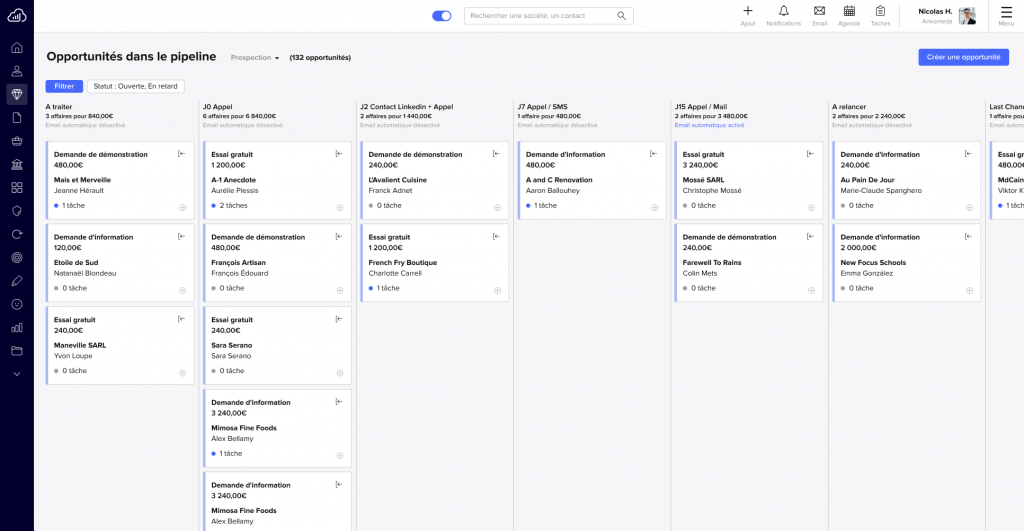Many tools have been developed over the years, such as the CRM (for the most complete solutions) but also the sales pipeline. A strategic tool whose purpose is to optimize all sales management, it has become essential. Here is an overview if you have not yet taken the plunge.
Related articles
- From Lead Generation to Lead Engagement: how to get started
- 7 things to consider before investing in a sales enablement tool
- How to lead a technology assessment in 4 steps
What is a sales pipeline?
If we have to give a simple and synthetic definition, the sales pipeline provides a global vision of the current sales activity. It allows a sales person to follow the progress of his opportunities step by step.
If we go a little further, each step can even be associated with a probability that your prospect will go on to sign a contract. You will therefore understand the twofold interest of the pipeline:
- It allows you to perform the right actions at the right time
- The sales team can visualize the opportunities in concrete terms to build a sales forecast
Example of a sales pipeline view:

In its construction and to obtain simple steps to follow, there are at least the following 4 main phases:
- Making contact
- The request for an appointment
- The meeting is over
- Sending a proposal
Depending on the type of business and the sales process, the cycle can be much longer and at this point, your pipeline will be enriched with additional steps that separate the contact from the closing.
The benefits of the sales pipeline
If we focus solely on the sales aspect, the pipeline allows you to structure your sales process, manage the prioritization of tasks and progress efficiently with prospects.
The end result for your sales representative: to remain focused on his or her core business and on what makes him or her valuable: finding and retaining customers through a trusting, personalized relationship with them.
Let's take a step back and look at the sales pipeline from the perspective of a sales manager. The tool will then take on a managerial dimension allowing him to better manage his team and create/maintain a real sales dynamic.
The benefits are multiple, including :
- Definition of new prospecting sectors
- Establishment of a sales forecast report
- Alignment between sales and marketing departments
- Identification of the stages requiring more in-depth support for the sales teams
- Analysis of the strengths of the sales force
- Training to be planned
Regardless of the prism used, the ultimate goal is to accelerate the growth of the company.
Sales pipeline and automation
Another advantage of the pipeline is that it can be linked to sales or management software such as a CRM to automate a number of time-consuming manual tasks during the sales process:
- Email follow-up
- Event creation
- Sending documents
- Action tracking
These are the most common examples. For example, tracking allows you to follow up with a prospect at the right time following an action performed by a lead: did he visit your site? Did they read your quote?
This information can be used to automatically send an appointment proposal or additional documents.
Within the framework of a sales process automation, you will also be able to industrialize your prospecting strategy. When an opportunity changes stage in the pipeline, it is usually because an action must be taken. At this point, notifying the customer can become interesting in some cases with a dedicated email template sent automatically when the opportunity changes location in the pipeline.
How to properly set up your sales pipeline(s)
To get the most out of your pipelines, we give you 4 best practices:
- Standardize your pipelines: the flexibility of the tool can be an obstacle to its use when each salesperson starts to create a specific pipeline for his or her process. For a team manager, several problems will quickly arise, such as the impossibility of accurate reporting or comparing pipelines with each other
- Keep your pipelines active: the power of the pipeline lies in its ability to provide a synthetic view of the current business activity. It is therefore important that your pipeline only consists of active opportunities
- Maintain your pipelines: in relation to the previous point, what to do with dormant opportunities? You can define rules such as, for example, as soon as an opportunity has a recall of more than 3 months, it is transferred to a nurturing circuit with email sequences dedicated to the discovery of your products/services or reassurance
- Review the pipelines: here, it is simply a matter of avoiding the salesperson, who after a good month, would keep opportunities "under his or her foot" for the next period. Organize meetings at the beginning or end of the week to review the pipelines and the opportunities available
In conclusion, the pipeline is now a great tool for monitoring and automating certain sales tasks. However, you should never forget to use common sense to define rules that allow you to exploit its potential to the full.